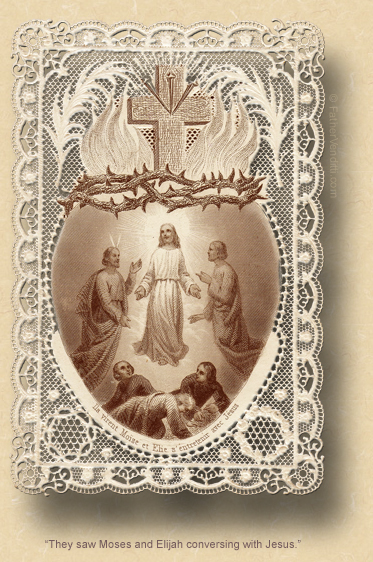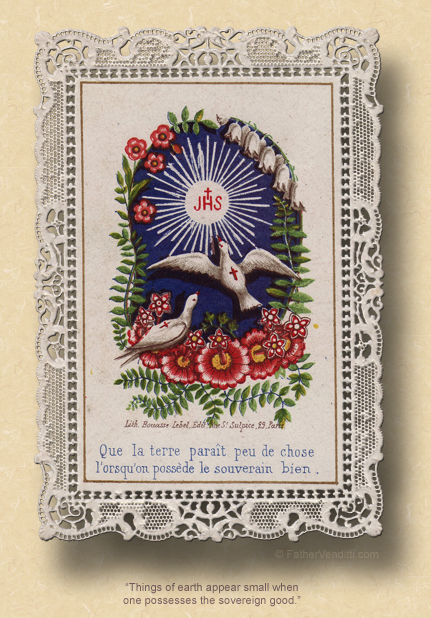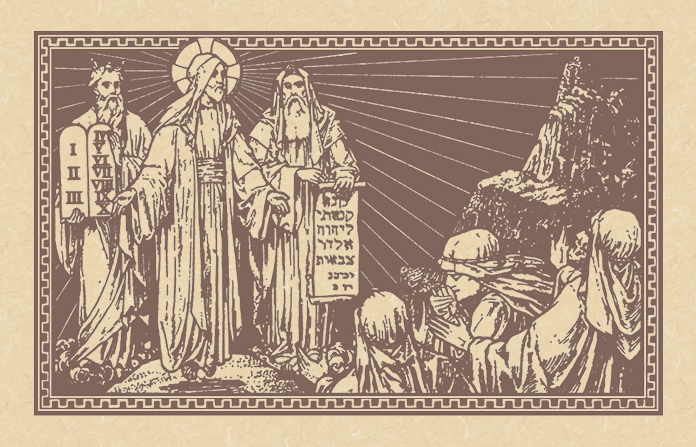God Always Has His Purpose.
The Feast of the Transfiguration of the Lord.
Lessons from the proper, according to the ordinary form of the Roman Rite:*
• Daniel 7: 9-10, 13-14.
• Psalm 97: 1-2, 5-6, 9.
• II Peter 1: 16-19.
• Matthew 17: 1-9.
The Second Class Feast of the Transfiguration of Our Lord Jesus Christ; and, the Commemoration of Saint Sixtus II, Pope & Martyr, and Saints Felicissimus & Agapitus, Martyrs.
Lessons from the proper, according to the extraordinary form of the Roman Rite:
• II Peter 1: 16-19.
• Psalm 44: 3, 2.
• Matthew 17: 1-9.
The Solemn Holy Day of the Transfiguration of Our Lord, God and Savior, Jesus Christ.
Lessons from the pentecostarion, according to the Ruthenian recension of the Byzantine Rite:
• II Peter 1: 10-19.
• Matthew 17: 1-9.
FatherVenditti.com
|
 7:56 AM 8/6/2017 — A couple of weeks ago we observed the Feast of the Blessed Apostle James, one of three Apostles who were special friends of our Lord, and one of the clues of that was the fact that James was among the three who were permitted to witness our Lord's Transfiguration. But we also observed that it was these same three Apostles who were blessed to be with our Lord during His Agony in the Garden. These two events, then, become somewhat like bookends to the most significant part of our Blessed Lord's life on this earth: the one, a manifestation of His Divinity, as He appears to them in his heavenly glory; the other, a profound witness to His humanity, as He weeps in recognition of the great cross by which He is to suffer and die. 7:56 AM 8/6/2017 — A couple of weeks ago we observed the Feast of the Blessed Apostle James, one of three Apostles who were special friends of our Lord, and one of the clues of that was the fact that James was among the three who were permitted to witness our Lord's Transfiguration. But we also observed that it was these same three Apostles who were blessed to be with our Lord during His Agony in the Garden. These two events, then, become somewhat like bookends to the most significant part of our Blessed Lord's life on this earth: the one, a manifestation of His Divinity, as He appears to them in his heavenly glory; the other, a profound witness to His humanity, as He weeps in recognition of the great cross by which He is to suffer and die.
In today's feast, the fact of our Lord's Divinity is put before these three Apostles in a most serious way. It's prefigured for us in our first lesson from the Book of Daniel, and Saint Peter, in our second lesson, gives us his own eye-witness account of it. The Gospel lesson is, of course, most striking of all, especially in that Saint Matthew seems to have recourse to words inspired by the Book of Daniel. It must have been quite a revelation for him, as he was inspired by God to write this account down, to realize how completely our Lord fulfilled what Daniel prophesied.
For us, there are so many different points we could glean from our Lord's Transfiguration on Mount Tabor; but, I think it might be better to keep it short and simple today, and just let the feast speak for itself, except maybe for this one thought: the envy we should have for these three fortunate Apostles, that they were so blessed to be with our Lord at this moment. Msgr. Escrivá alluded to this in one of his homilies: what it would be like to see Jesus as he really is in heaven. Quoting Psalm 26, he wrote, “Vultum tuum, Domine, requiram (26: 8). 'Lord, I long to see your face.' I like” he said, “to close my eyes and think that, when God wills, the moment will come when I will be able to see him, not as 'in a mirror dimly, but … face to face'” (1 Cor. 13: 12).
I think that's very true. We all have our favorite images of our Blessed Lord that form the substance of our own personal devotion: Jesus as a child in the manger; Jesus as a young man preaching and calling around him his first disciples; Jesus performing many cures and miracles; Jesus going so willfully to his passion and hanging on the Altar of the Cross; but, these are all images of Jesus in His incarnation; and, there must be—or perhaps it's better to say there should be—a longing deep within us to see Jesus as He really is. Not to suggest that He wasn't really here, because He was, and still is in the Blessed Eucharist; but, we all know that Jesus now is enthroned in His heavenly glory, and that we won't see Him that way until, God willing, we join him there. Only then, as Saint Paul said, will we truly see Him not as “in a mirror dimly, but … face to face.”
I like to think that it was something like this that prompted Pope Saint John Paul II to include the Transfiguration among the Luminous Mysteries of the Rosary: to help us realize that the Jesus we pray to, the familiar images of whose life on earth form the basis of our devotional life, is an image of our Lord that is incomplete. Peter, James and John were granted a vision of Christ in His completeness in the Transfiguration, but it was still just a vision; they wouldn't come to see the real thing until they themselves entered into their own heavenly glory, as we hope to one day.
And I tend to think that this is why the creation of the Luminous Mysteries is so significant: because all of them—the Theophany at our Lord's Baptism, the first miracle at the Wedding at Cana, the Proclamation of the Kingdom of God, the Transfiguration, and especially the Institution of the Most Holy Eucharist—are all elements of our Lord's life that force us to wrench our thoughts out of this world and into the next.  Not to say that the other mysteries don't do that; certainly there are heavenly realities to be considered in the Immaculate Conception, the Assumption, the Coronation, not to mention the Resurrection of Christ himself; but there is something about the Luminous Mysteries that propels us in our prayer into another world, that forces us to rise up in prayer out of an exclusively incarnational approach to our faith, and realize that we are only pilgrims on this earth, and that, one day, we will leave all this behind. Not to say that the other mysteries don't do that; certainly there are heavenly realities to be considered in the Immaculate Conception, the Assumption, the Coronation, not to mention the Resurrection of Christ himself; but there is something about the Luminous Mysteries that propels us in our prayer into another world, that forces us to rise up in prayer out of an exclusively incarnational approach to our faith, and realize that we are only pilgrims on this earth, and that, one day, we will leave all this behind.
But, as I said, there are two heavenly bookends to our Lord's life: these three favorite Apostles, whom we envy because they were permitted to see this great vision of our Lord in His heavenly glory, couldn't simply walk away with that; they had also to be present at the Agony in the Garden, and that's because the road to heaven is the Way of the Cross. And it's important to note, I think, that this magnificent vision doesn't last but for a few moments. The three Apostles cover their faces as our Lord's face shines like the sun and his garments become as white as light; but, no sooner do they look up and it's over, and there they are alone with Jesus, Moses and Elijah having gone back to their lunch or whatever they were doing in heaven, and it's time to go back down the mountain and get on with the work at hand. And don't we all have moments like that? An inspiration will come to us—because of a sermon we heard or a book we read or maybe something that came to us in prayer—and it fills us with a momentary joy, and perhaps even causes a new resolution in us to do something or to adopt a new attitude toward our own spiritual combat; but, it's over as soon as it happens. That's the Mystery of the Transfiguration. And it should not disturb us, because that's what our Lord intends all along, just as He knew that the three Apostle who were permitted to witness the Transfiguration would have to witness Him weep in the Garden, too. The one makes the other necessary; the other makes the one possible; both together point us in the right direction, which is to orient our life toward heaven. God always has his purpose.

* In the ordinary form, the first three lessons for this feast are unchanging, while three selections for the fourth lesson are given which correspond to the three dominical cycles.
|

